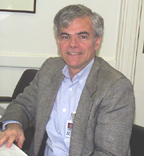
| T H E N I H C A T A L Y S T | J A N U A R Y – F E B R U A R Y 2003 |
|
|
|
| F R O M | T H E | D E P U T Y | D I R E C T O R | F O R | I N T R A M U R A L | R E S E A R C H |
THE
POSTDOCTORAL EXPERIENCE AT NIH:
SOME
NEW IDEAS
 |
| Michael Gottesman |
"...one
aspect of the intramural program deserves special mention and emphasis. It is
as a training ground for young investigators . . . that the institution has
achieved its most singular influence on the progress of American science."
—Lewis
Thomas
("NIH: An
Account of Research in Its Laboratories and Clinics,"
DeWitt Stetten,
Jr., Editor; Foreword, p. xviii, Academic Press, 1984)
There are 3,200 postdoctoral fellows at NIH, reflecting our enormous and long-standing commitment to, and responsibility for, training the next generation of biomedical researchers. In this column, I have frequently written about the imperative to provide appropriate mentoring and training experiences for our fellows and have tried to use this bully pulpit to stimulate the formulation of guidelines and guides to codify high standards for training at NIH.
|
The next step is to acknowledge that postdoctoral training is the last major component of a continuum of academic training whose success is measured by how well our fellows are prepared for a career in biomedicine. . . . Extended training should not unnecessarily delay the start of independent careers. |
As a result of the efforts of the Scientific Conduct and Ethics committee at NIH, chaired by Joan Schwartz, assistant director, Office of Intramural Research; the NIH Fellows Committee (FELCOM); and the Scientific Directors, several documents have been created and revised to reflect the high, evolving standards we have set for ourselves in postdoctoral training and mentoring. http://www1.od.nih.gov/oir/sourcebook/comm-adv/sci-conduct.htm
The "Guide to Training and Mentoring in the Intramural Program" provides an outline of our goals and expectations for both mentor and trainee. This has recently been supplemented by three appendices created by the Scientific Directors, reflecting advice derived from a mentoring survey developed by FELCOM.
As requested by the fellows, these documents provide specific guidelines for the mentor and for the trainee, along with a list of topics the mentor and trainees should discuss as part of the annual evaluation of each postdoctoral fellow. We have asked the institutes to follow these guidelines within all parts of the intramural program, with annual evaluations beginning this year.
We should not stop with the use of these documents. The next step is to acknowledge that postdoctoral training is the last major component of a continuum of academic training whose success is measured by how well our fellows are prepared for a career in biomedicine. This future will require expertise in subject areas that not all our fellows had the opportunity to acquire in graduate school. Training should reflect the need to develop a multidisciplinary workforce, to make optimal use of the special resources at NIH, and to respond appropriately to the skills and talents of our individual fellows.
At the same time, recent trends indicate that the age at which scientists become independent is increasing, and this extended training should not unnecessarily delay the start of independent careers.
Thus, I propose that in addition to the excellent laboratory and clinical research opportunities currently available to our fellows, we develop a more formal postdoctoral training program with the following characteristics:
![]() Availability to all postdoctoral fellows of coursework in subject areas such
as bioinformatics, genomics, integrative biology, and translational research
Availability to all postdoctoral fellows of coursework in subject areas such
as bioinformatics, genomics, integrative biology, and translational research
![]() Cross-training in multiple disciplines, perhaps through co-mentoring arrangements
(the new joint NIH-NIST fellowship in biology and physical sciences is a pilot
example of such interdisciplinary training)
Cross-training in multiple disciplines, perhaps through co-mentoring arrangements
(the new joint NIH-NIST fellowship in biology and physical sciences is a pilot
example of such interdisciplinary training)
![]() Development of requirements for a certificate-of-training in the intramural
program, reflecting areas of greatest scientific strength at NIH
Development of requirements for a certificate-of-training in the intramural
program, reflecting areas of greatest scientific strength at NIH
![]() Improved career counseling and specific guidance and coursework to help fellows
achieve their career goals
Improved career counseling and specific guidance and coursework to help fellows
achieve their career goals
![]() Discussion and development of milestones for postdoctoral training to facilitate
achievement of goals within a reasonable period of time.
Discussion and development of milestones for postdoctoral training to facilitate
achievement of goals within a reasonable period of time.
I hope these ideas will be widely discussed among our principal investigators and fellows. I have assembled a group of scientists and educators to develop specific implementation plans for consideration by the Board of Scientific Directors and other senior NIH leaders. The goal is to develop new concepts for postdoctoral training in biomedicine and to make the postdoctoral experience in the NIH intramural program even more attractive and effective.
—Michael
Gottesman
Deputy
Director for Intramural Research